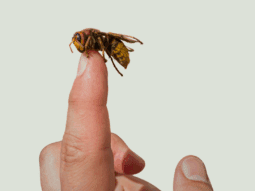
Termite Swarmers - What You Need To Know
What You Need to Know About Termite Swarmers in TX, OK, MS, LA
It may sound like a freaky sci-fi movie, but swarms of termites invading your home is a real and common occurrence. Termite colonies produce “swarmers” during certain times of the year for their survival and propagation. These pests are winged adults at the peak of their reproduction. They leave their current colony to form their own. If you notice them flying around your house, that means they’ve most likely recently moved from an underground nest into your yard. Now, they’re ready to invade your home’s interiors by squeezing in through any crack. Since they’re attracted to light, you may spot these creatures near a window or exterior light fixture.
Though these insects have wings, they fly poorly. A sign that your home in Texas is under attack is a sudden appearance of hundreds of small brown or black termite swarmers. If you live in Dallas, McKinney, Plano, or anywhere close by, you need to pay attention to this phenomenon to avoid property damage. You can identify these swarmers with these features: two sets of identical wings, a thick waist, and straight antennae akin to a bead. Remember, a termite swarm could mean you already have an infestation.
When Does Termite Swarming Season Happen?
The occurrence of swarmers depends on the subgroup. In general, termites stay active when the weather is warm. They usually swarm a day after a rain shower, preferring overcast weather and when the breeze is under six mph. They love the warm, damp soil as it helps the newly paired mates build a new nest. The survival rate is also higher when it is a bit moist, as opposed to it being extremely hot. The swarming frenzy can occur from February to autumn, depending on the species. However, this doesn’t mean it can’t happen in winter, as swarms have been inside heated barns and other similar structures.
The most common period of swarms happens from late spring to early fall. Eastern subterranean termites swarmers move around in the months of spring in the morning. Meanwhile, drywood termites take flight in the late summer or early autumn. As for dampwood termites, they stay in full bloom in summer. Since Texas has a warm climate, you can expect termite swarming season to begin earlier and last even longer than in any other area of the US.
According to a study conducted by The University of Arizona, termites are not necessarily evil. They are part of the life cycle and act as decomposers to break down deadwood. With this process, the deadwood returns to the soil as humus. However, it only becomes terrible when termites invade your property and cause damage. As you can see with the different termite species mentioned above, swarming spans a long period, so it is essential to protect your home all year-round. It is vital to take precautionary measures and stay vigilant as these destructive pests may wreak havoc on your property.
Why Does Termite Swarming Season Happen?
Termites begin swarming when their original colony has reached its capacity. Colonies stay a certain size, and when mature termites are ready for reproduction and expansion, they move away to build their own colony. For most colonies, expect it to happen once a year. Hundreds of thousands of termite swarmers dubbed as alates are bred for reproduction. The number of swarmers depends on the termite colony size and species. Both male and female alates nest in the soil and wait for the perfect environmental conditions to take flight.
When the time is right, you can finally see the swarmers launch into the air, where they pair off to find a mate. Once they successfully find a partner, they shed their wings to reproduce and establish a new nest. They actively populate and build their own colonies. It may seem like the swarms linger in your yard because these alates take flight over several days. There’s one major release in the beginning, with smaller groups taking flight on the following days.
Why Should You Be Concerned With Termite Swarms?
Termites are naturally predisposed to chew on wood. The problem lies in the cities that people built, as most of them possess wooden structures that termites love. Unfortunately, these pests are attracted to all things wood, especially those that show signs of rot or decay. Hence, it can lead them to your home or commercial property. With their massive population and the speed at which they multiply, termites have the power to do major damage to your wooden structures if you leave them untreated.
The key is to ensure they never get a foothold in your property. Once termites appear indoors, it is a sure indicator that you’ve got worker termites actively ingesting wood in your home. Unfortunately, concrete slab foundations are the primary target for this activity. They can enter your home by a tiny crack. They create hidden mud tubes to infiltrate your property, resulting in extensive structural damage that could result in expensive repairs.
Unfortunately, a study conducted at Michigan State University exhibits that the damage happens slowly and may, at times, even go unnoticed. Often, it takes several months or even years for property owners to see termite damage. By then, you may need complex chemical treatments and costly construction repairs. For this reason, you need a termite control professional to regularly inspect your property to nip any form of termite activity in the bud.
What Can Professionals Do?
A bunch of termite swarmers indicates that you’ve got a colony congregating nearby. If you see these swarms hovering near your house or business, be alarmed. Call a reputable pest control company for an immediate inspection so professionals can find the source of the problem and administer safe solutions to drive away these pests. With regular treatment, you can keep these swarms and colonies at bay for good.
If you spot swarmers, discarded wings, damaged wood, or blisters in your wood, get in touch with our team at Romex Pest Control. We provide services for residents of Louisiana, Mississippi, Oklahoma, and Texas. Our team has the tools, skills, and expertise to deal with your termite problem. Usually, termites build mud tubes as big as pencil diameter traversing several feet. They do this underground or within walls away from your eyes. With our help, we can find these hidden areas and eradicate termites from your property.
We hope you enjoy these informational articles. If you'd like to learn more about our eco-friendly pest control services, call (844) 955-2447.
Read More
Your Path to a Pest-Free Home or Business
Romex Pest Control
We are committed to protecting you, your children, and your pets with our eco-friendly, child-friendly, and pet-friendly guaranteed pest control solutions.
Romex Pest Control is fully insured and licensed in Texas, Oklahoma, Louisiana, and Mississippi.
Service Areas:
Hours
M-F 8 am–5 pm
Sat 8 am–2 pm
Sun Closed
Established 2016 © Copyright 2025 Romex Pest Control










